Growing healthy pepper plants and big harvests comes from attentive care throughout the season. One of the most important processes is transplanting young pepper seedlings.
Transplanting is an important skill to master for growing peppers. Whether you start indoors, or buy your plants from the store, you’ll need to transplant them properly, and at the right time.
In this article, I’ll share my process on how to transplant pepper plants. It is very simple, but timing and technique are important to avoid damaging your plants or slowing down growth. Let’s get started!
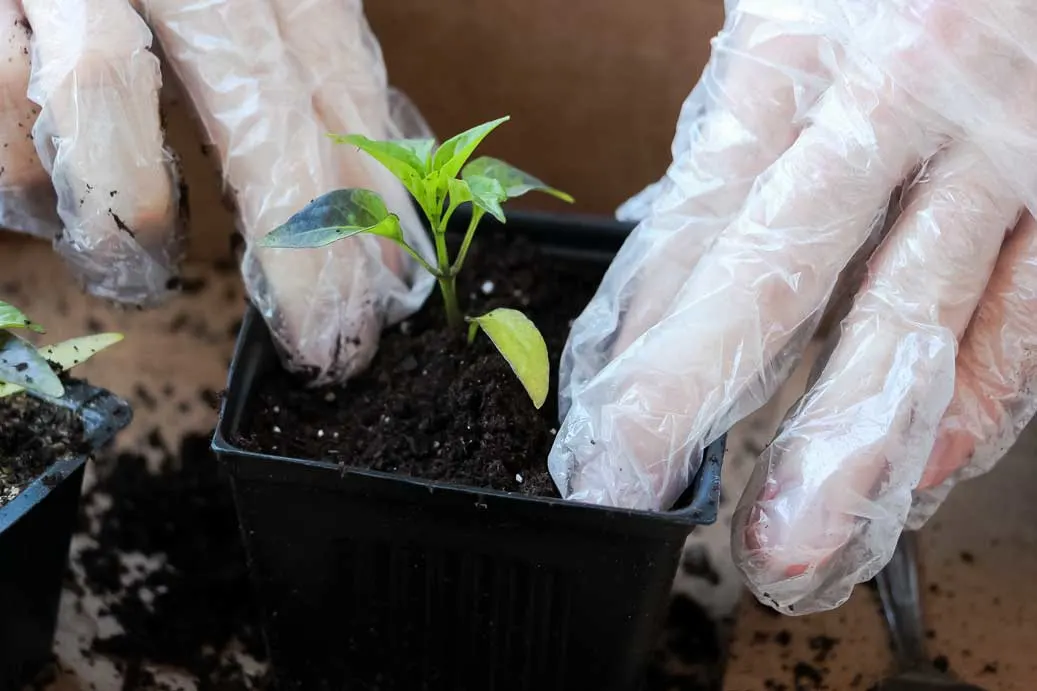
Skip Ahead:
- What is transplanting?
- When to transplant peppers
- What you’ll need
- Step-by-step instructions
- Why not move straight to full-sized pots?
How To Transplant Pepper Seedlings (Video):
What Is Transplanting
Transplanting is the process of moving a plant from a smaller container to a larger one. This allows the plant to continue growing a larger root system. Without transplanting, your plants cannot reach their full potential.
Why transplant?
Keeping started plants in small pots for too long can cause a number of problems. The main issue is that the roots have nowhere to expand and grow.
This means that the root system will become entangled, or ‘root bound,’ making a later transplanting more shocking and disruptive to the plant’s health. This is why it is important to get the timing of your transplant right.
Another problem that can arise from not transplanting is stunted foliar (leafy) growth. Without transplanting, your pepper plants will likely grow tall and leggy without as many branches and leaves.
Stunted growth is caused by the root system’s inability to uptake the nutrients required to fuel a larger plant. This is why the size of your final planter will determine the maximum size of your pepper plant.
When To Transplant Pepper Seedlings
We often start our seeds in small seed cell trays, 6 plants per tray. About 3-4 weeks after sprouting, pepper seedlings should be ready to move into larger pots. After the plants begin to produce their 2nd or 3rd set of true leaves, they are ready to be transplanted.
Timing of planting and potting-up can vary based on the variety of pepper. Learn when to plant pepper seeds here.
For example, hotter peppers tend to grow slower, meaning the root systems may not develop as quickly as bell peppers or jalapeños. If your plants seem too small by week 4, give them an extra week before moving them into larger pots.
Tip: If you’re not sure if your plants are ready, peak at the root system by gently loosening the plant from the seed cell. If you can see a strong root ball with white roots all the way to the very bottom, your plant is ready to be transplanted. Ideally, you want to transplant before the roots start to coil.
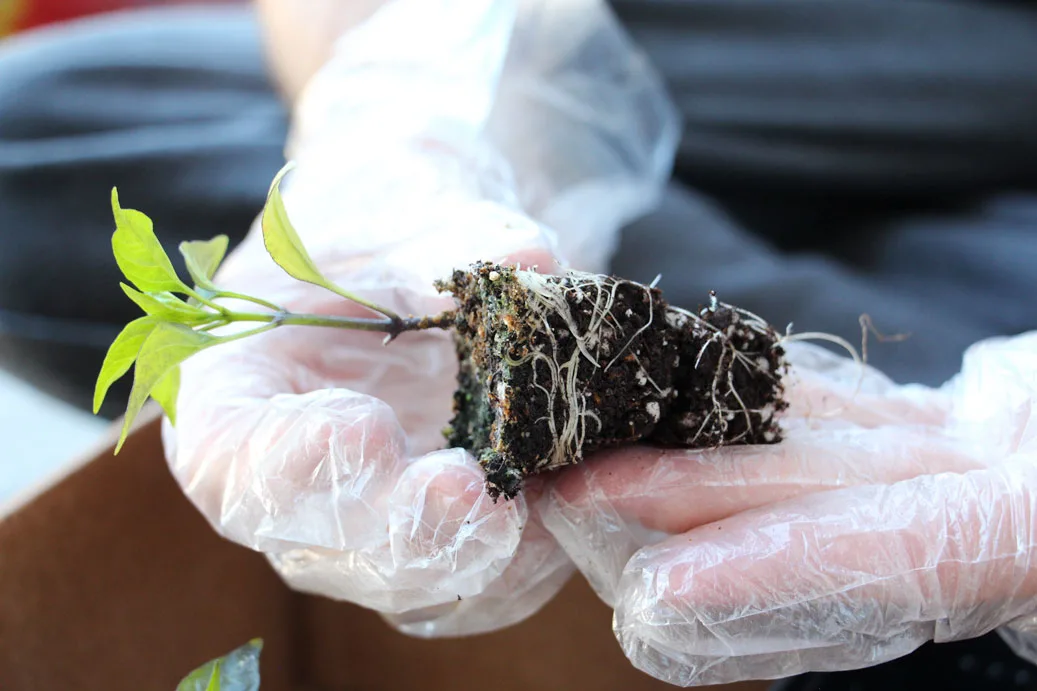
Items You’ll Need For Transplanting
Transplanting is almost as simple as it sounds. You have your timing right, now all you need are a few items to ensure success. We’ve listed the items we use for transplanting our pepper plants, and where you can buy them online.
1. Pots (3 Inch)
These are the perfect size-up from seedling trays. They allow significantly more soil and retain water for much longer. You may also plant seeds directly in 3 inch pots, and transplant them directly into their final location from there.
2. Pruning Shears
Pruning shears are used to cut away any additional sprouts at the base of their stem. Each seed cell should have just one plant. I have heard of some gardeners allowing multiple plants to compete in close proximity, but I’ve yet to experiment with this. I recommend just one plant per pot.
Note: You’ll also want pruning shears if you plan to top off your peppers. Learn more about pruning here.
3. Potting Soil
After your seedlings have grown for 3-4 weeks, they are ready to handle nutrient-rich potting soil. The fertilizer is necessary for pepper plants to develop healthy foliage and structure during the early plant stages.
If your plants have any nutrient deficiencies, you will notice abnormal characteristics. These often include yellowing leaves or curling leaves on pepper plants.
Other household items needed:
- Water
- Gloves (optional)
How To Transplant Pepper Plants
So you’re ready to transplant! Now it is time to take the steps to get it done. We prefer to get this all done in one go, but it can be back-breaking if you don’t have the right space for it.
What is a rootball? The rootball is the root system of your plant, the part of the plant that is below the soil surface.
How To Transplant Pepper Plants (Steps):
- Get the required items.
Make sure you have enough larger pots (we use 3-inch pots when transplanting seedlings) and potting soil.
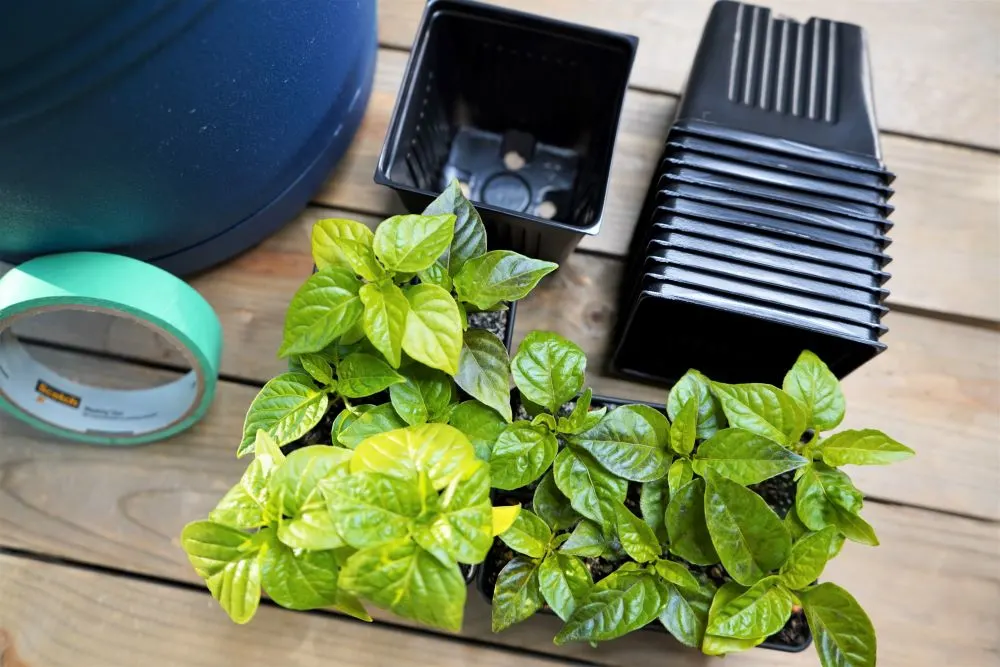
- Label new pots.
Organization is key! Don’t lose track of which plants are which. Use tape or a permanent marker to label each new pot with the plant variety.
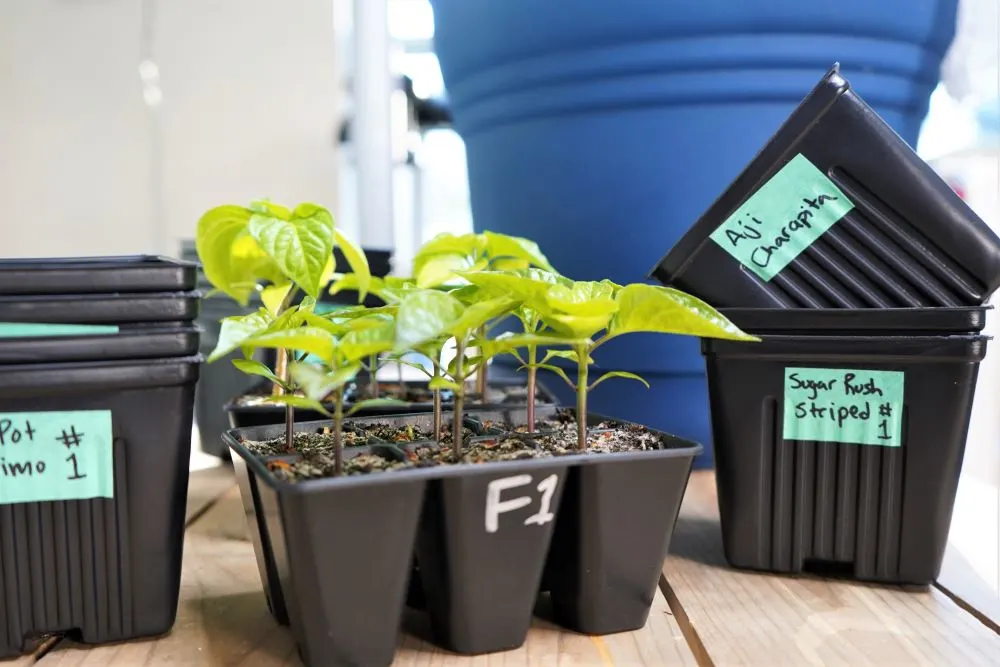
- Prepare a work station.
Transplanting pepper plants is messy. Ideally, you should work outdoors. If you don’t have an outdoor space, put down some cardboard or newspaper to save your floors from a dirty mess. This can also be hard on the back if you have a lot of plants, so consider spreading out the work over multiple days.
- Pre-moisten soil
Start with a small amount of water and work the soil over to moisten evenly. Add water until it is just moist but not soaking wet! It should slightly stick together but not feel muddy. If it gets too wet, add more dry soil.
Tip: Use gloves to avoid dirty fingernails.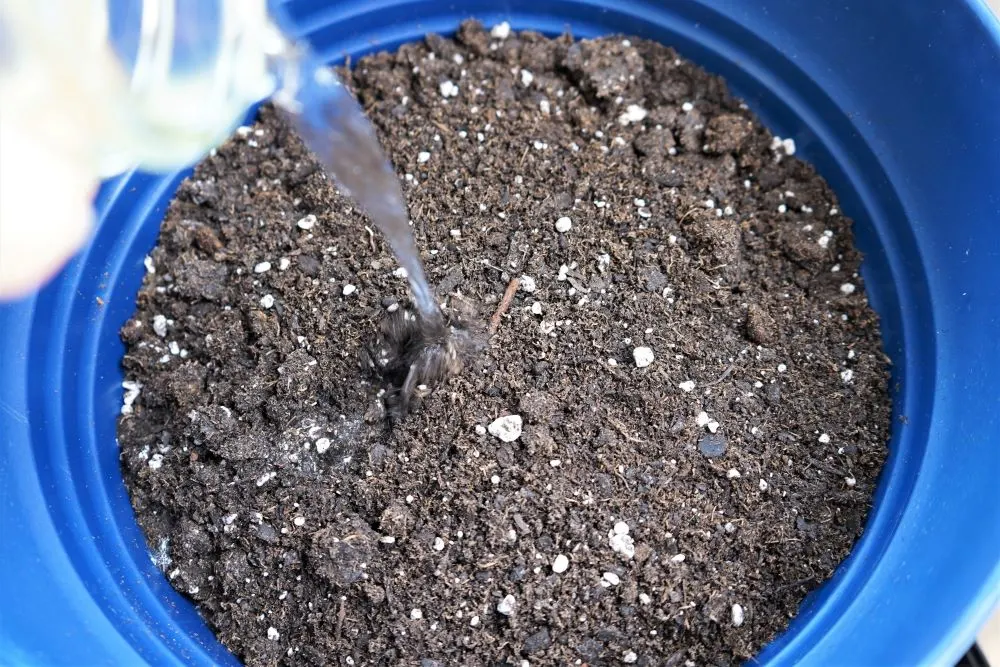
- Fill 3-inch pots with ~1 inch of soil.
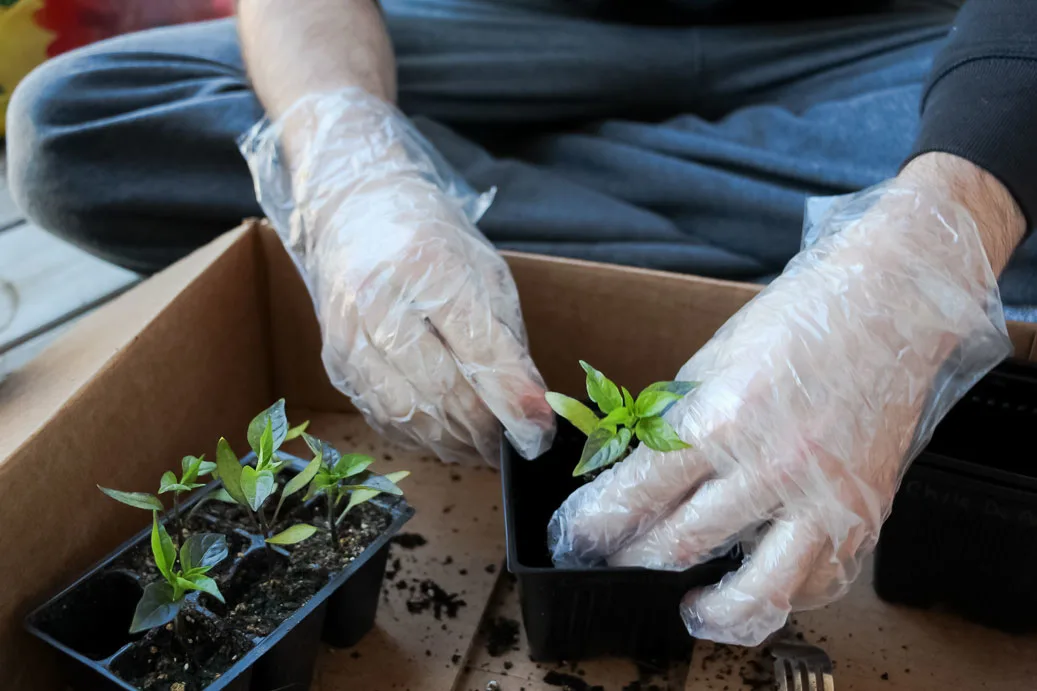
- Gently remove plants from seed trays.
Loosen the plant by gently squeezing the seed cell on all sides. The plant can then easily be removed from the cell by turning the tray upside down and holding the plant by its upper foliage. Be careful not to damage the stem of each plant.
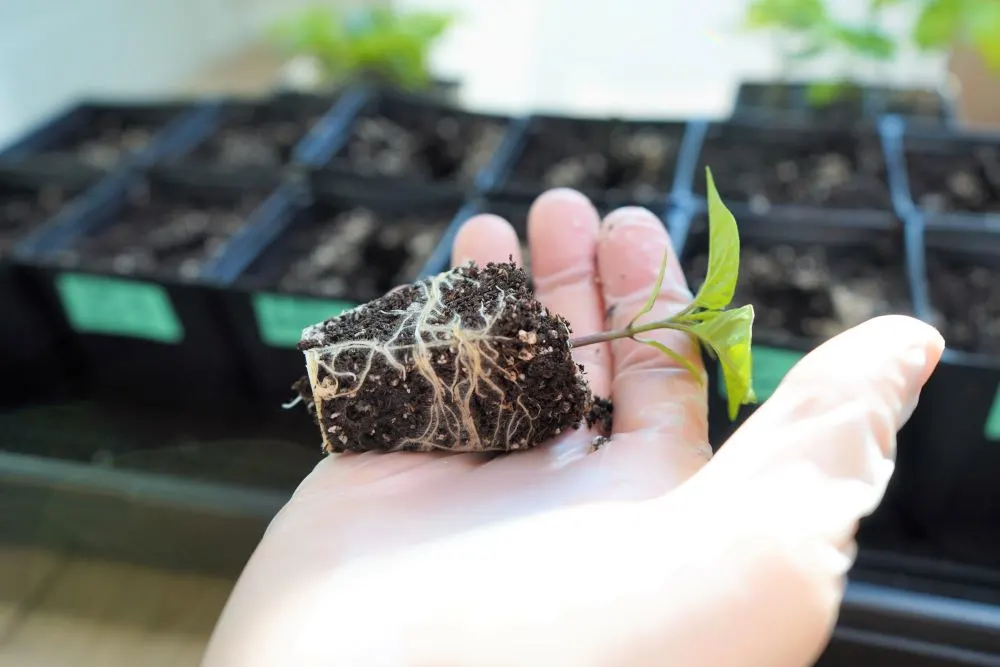
- Place the plants in new pots and surround with soil.
Allow the soil to surround the rootball naturally, filling in empty spots. Fill the pots to about 1/4 inch from the top. Avoid burying the plant’s main stem, planting at its original depth.
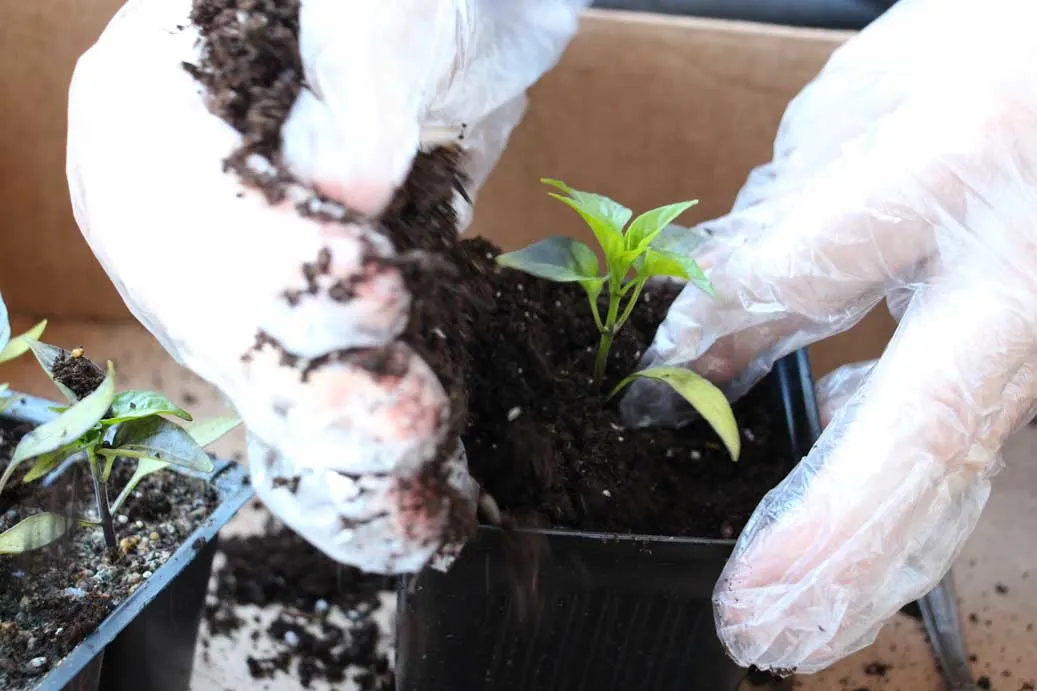
- Gently pack down the soil and top off.
Pack the soil gently with your fingers to ensure that there is good contact with the rootball. Top off with soil to keep the pots full.
- Water lightly.
To ensure each plant has a healthy transition, water lightly. This will join the old soil with the new and begin delivering nutrients to the roots.
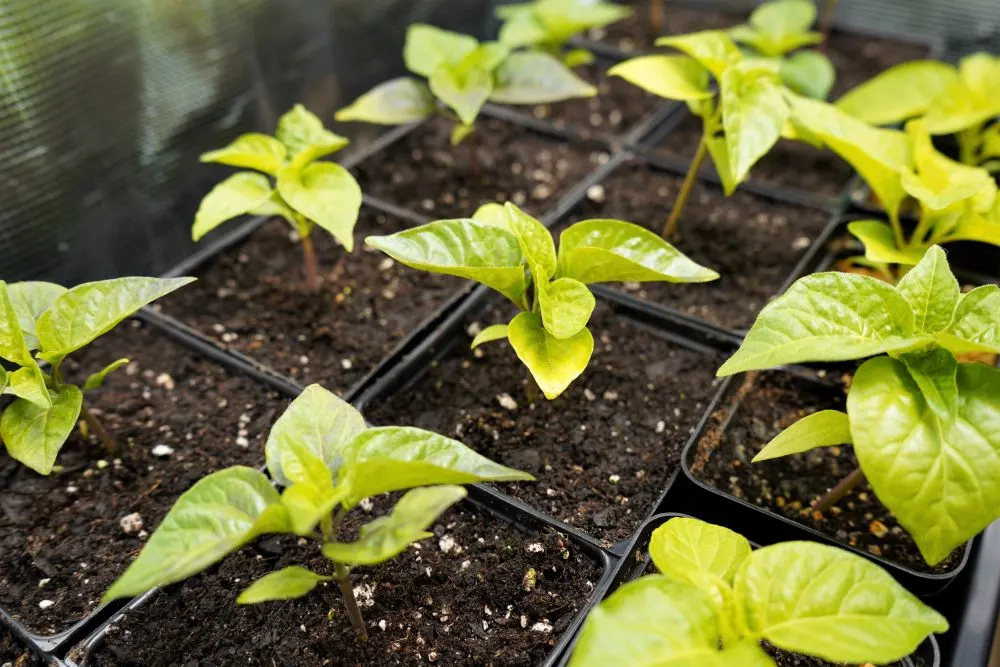
- Prune any additional plants.
If multiple seedlings sprouted in any of your seed cells, prune away the weaker plants with pruning shears, leaving one per container.
When Do I Move Peppers Into Large Pots?
One question we see a lot is, “Why not just move the seedlings into a large container?” There are a few reasons that we gradually increase the size of the container for the plants.
Indoor Space
The biggest reason to keep the young plants smaller pots is to save space. We grow many different pepper varieties each year (usually 50+ plants), and if we put each seedling into a 5 gallon pot, we would run out of indoor space before the weather was warm enough!

However, this doesn’t apply to all growers. If you only have just a few pepper plants to worry about, you may wonder if you can simply put the seedling-sized plants into their final pots right away. There is one other important reason that we would not recommend it.
Water Usage
When your pepper plants are small, they don’t drink too much water. However, a 5 gallon pot of soil will hold a lot of water that your plant is not yet large enough to use.
Without a large enough plant living in that soil to uptake the water, most of it will simply sit in the container. This moist environment in the unused soil is the perfect environment for other things to develop, such as mold and unwanted fungus.
By moving the seedlings into slightly larger pots, they will grow more quickly, and use the water within their pots more efficiently. The same is true for planting seeds – if you plant directly in a large pot of soil, the plants may grow more slowly.
The next step after transplanting is hardening off your pepper plants to acclimate them to the outdoor elements. Beyond this, your peppers will be on their way to producing harvests!
I hope this guide helps you learn how to transplant pepper plants this year! Don’t hesitate to ask questions or reach out with any suggestions. Good luck!

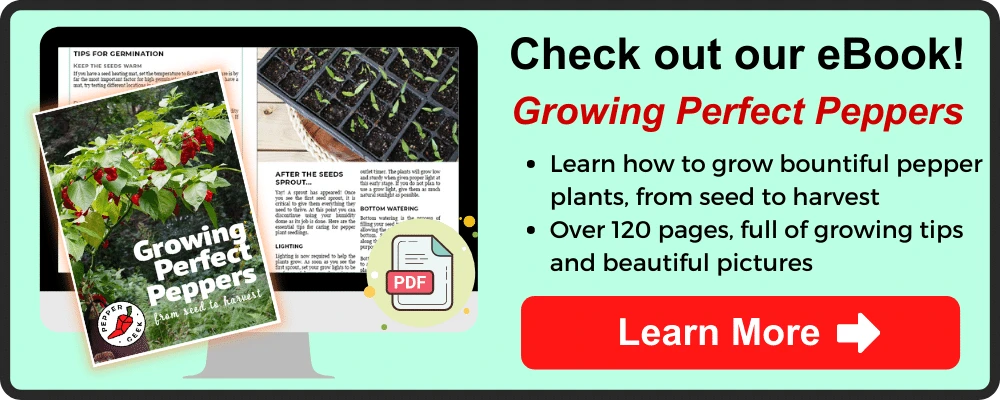
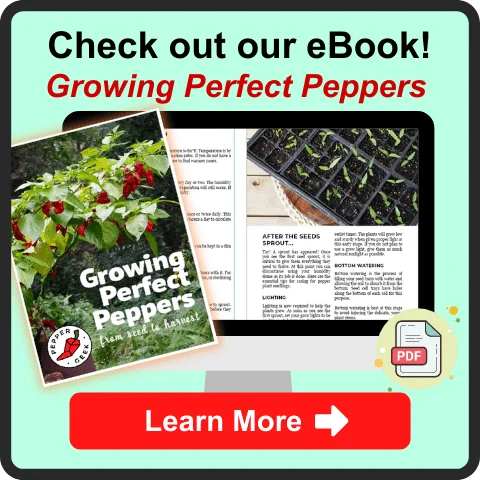

k
Sunday 7th of April 2024
can you harden them off at 3 inches or 4?
peppergeek
Wednesday 17th of April 2024
Yes, just be careful of bunnies and deer!
John-Richard
Sunday 7th of April 2024
Thanks, Calvin. You’re awesome, and I love the many things I learn by reading your posts and watching your videos. I am not a hot pepper kind of guy. My stomach cannot handle it. But, I do enjoy peppers for spices and sweet peppers. The Roulette F1 and the Grenada pepper and the various paprika peppers are some of my favorite spice peppers as is the shishito. This year I am going to try the Candy Cane bell pepper and the Thunderbolt. Oh, and my go tos are Carmen, Jimmy Nardillo, Doe Hill, and Cherry pepper. There are a couple of others, but there is only three of us and not much space to grow more. Dad wouldn’t be happy either, if I took up more of the backyard. Anyway… thank you. You have brought me a long way from where I was 3 years ago.
peppergeek
Wednesday 17th of April 2024
That's great to hear, I'm glad we could be helpful. Sounds like a good assortment of sweet peppers with a touch of heat. Shishito is great, as are nardellos. Hope you get a great harvest this year 🌶️
Kirsten Williams
Sunday 7th of April 2024
I have seedlings that I planned on February. They were grown in 3in pots and I'm starting to harden them off but they don't look nearly as far along as yours. I have 3 sets of leaves but most look like your planting cell peppers. Any advice on what I'm doing wrong? I live in Georgia and we're about a week past our last frost date.
peppergeek
Friday 19th of April 2024
Hm, could be lighting, nutrients, or maybe temperature. Usually the natural light outside encourages really healthy growth, so hopefully they're coming along better now with the hardening off process
Russell
Monday 26th of February 2024
I have been trying to find information for transplanting my Habanero to the 16" pot from the 3", but all I keep finding is transplanting the seedlings to the 3" !
John-Richard
Sunday 7th of April 2024
@Russell, I follow basically the same instructions, although I tend to mix my own soil. I have potted many of my pepper plants each year with great success. I just condition them for the outdoors by bringing them out on good days until temperatures even out and we get comfortable nights. Then I bring them out in the days and evenings. When I feel they are handling outside temps well, no discolorations and no wilting, then I transplant into my bigger pots outdoors following the same type of instructions as Calvin gave for the 3” pots. They then are ready to stay outdoors. However, if days get extremely warm I monitor their moisture or lack there of carefully, and may move potted peppers into the shade as the sun moves through the sky. Hope that is helpful. It has worked for me for 3 years now.
Alex
Sunday 11th of February 2024
Ever experimented with mixing a little worm castings with soil when transplanting? Do you think it could potentially cause drainage issues if overused?
k
Sunday 7th of April 2024
@Alex, i use a handful in every pot, it won't kill your plants
peppergeek
Monday 12th of February 2024
Worm castings are fine in moderation, I'd just recommend sticking to a set percentage. Pure worm castings don't make a good soil medium in my opinion